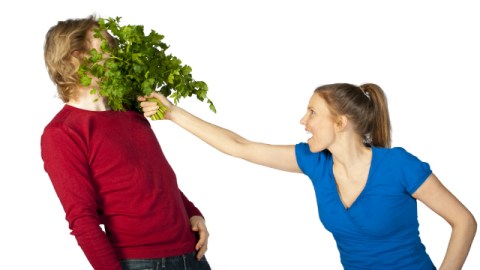The Food of Love?

Valentine’s Day is second only to Christmas/New Year’s among holidays whose joyousness or misery depends entirely on the quality of your relationships.
(There is, of course a third category of person – for whom this post will be meaningless – who views Valentine’s Day as a cynical marketing scheme for greeting cards [when, in fact, it’s probably a Christianized version of the ancient pagan fertility festival of Lupercalia, and its association with romantic love dates back to 16th century Europe.]).
Because our western fairytales teach us that true love is supposed to fall magically upon us (like Puck’s fairy dust in A Midsummer Night’s Dream), and because more of us believe it than we’d admit at a cocktail party, there’s something vaguely awkward about dating services. At worst, they feel like an admission of defeat – of failure to be chosen by Cupid for target practice. This is nonsense, of course, as the staggering divorce rates – regardless of how romantically or prosaically the couple met – will attest. At the same time, the evidence for online “matching algorithms” – the most promising dating innovation since the yenta – turns out to be pretty dismal, too.
There is ample evidence, however, that committed, romantic relationships are positively linked with well-being. So many people persist in seeking the perfect life partner, or at least a more or less workable one.
Dana Cowin, Editor in Chief of Food and Wine magazine and a passionate, longtime observer of food-related behavior, argues that food preferences are a powerful index to compatibility. She thinks there ought to be a dating service based on food (Foo-pid ? The Food of Love ? I couldn’t resist . . .). Cowin’s point is that our food preferences aren’t just a hobby – they speak volumes about our personalities and our general approach to life. A fois-gras-loving gourmand who dreams of touring vineyards in France, therefore, may have a tough time finding common ground – politically, aesthetically, and philosophically – with an ideologically driven raw foodist.
The idea that food and personality are deeply linked isn’t new. Ayurvedic medicine, traditional in India, identifies three major consitutional types, each associated with different kinds of foods that are supposed to enhance its dominant traits. Vata people, for example, tend to be sensitive, creative, and bad with money. Eating dry or bitter food is supposed to make them (or anyone) more so. Modern science, too, has revealed surprisingly specific facts like the connection between perfectionism and the urge to eat tortilla chips.
In our time, food has become incredibly fraught and politicized. There’s the American epidemic of obesity to worry about, along with the horrors of factory farming, which have evolved to a point that makes Upton Sinclair’s The Jungle look like Little House on the Prairie. Meanwhile, a worldwide recession is having its own, sometimes paradoxical effect on people’s eating habits. Now, perhaps more than ever before, you are what you eat.
In this context, and even accounting for her likely leaning toward food (and wine) as key ingredients in human happiness, Dana Cowin’s observation is especially compelling, and invites deeper study. One hypothesis supporting the food/romantic compatibility connection might be that what matters most is not what you eat, but how strongly you feel about it.
More broadly, eating habits and tastes, like love, are a central part of our human experience. Too often and too easily dismissed as a “soft” pursuit, food constitutes a significant part of the quality of our lives. And like all of our behaviors, our tendencies to eat quickly or slowly, to prefer sweets or savories, to shop at the farmer’s market or at Costco, are expressions of self that should provide meaningful clues to who we are, if only we could learn to decipher them.
Follow Jason Gots (@jgots) on Twitter
Image credit: Shutterstock.com





